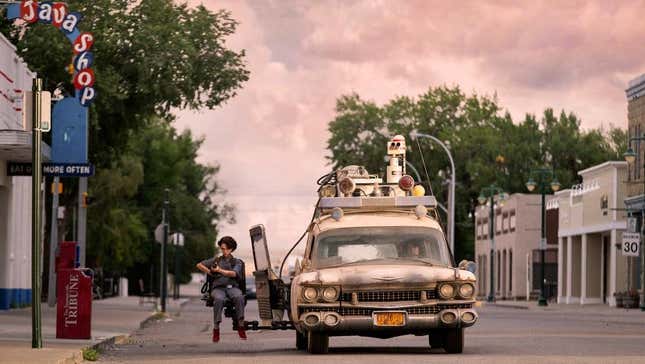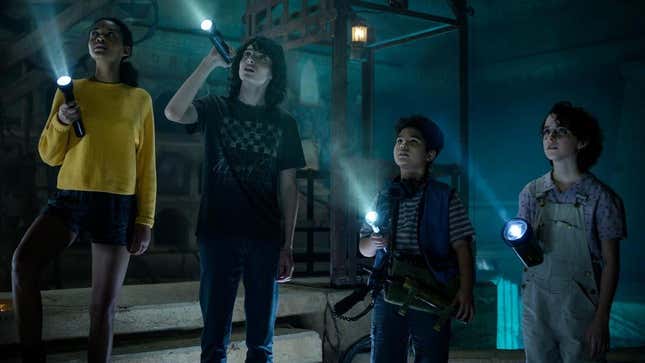
Ghostbusters: Afterlife is a film at war with itself, unsure of exactly what it wants to be. On the one hand, it’s a heartwarming tale of a family in need, forced out of their home, hoping to get a fresh start in life. On the other, it’s a sequel to two of the most beloved sci-fi comedies in film history. Throughout, those two pieces dance together—often harmoniously, sometimes not—until the latter takes over and almost fatally decays everything that worked beforehand.
Afterlife is directed by Jason Reitman (Juno, Up In The Air), son of Ghostbusters co-creator and director Ivan Reitman. Ivan produces this time around with Jason also co-writing along with Gil Kenan (Monster House). The story is set about 30 years after the events of Ghostbusters when a young single mother named Callie (Carrie Coon) is evicted from her home. This happens about the same time as her father—a mysterious figure we see only in shadow but with a lot of familiar equipment—is killed under odd circumstances. He leaves Callie his farm in the small town of Summerville, Oklahoma and so, with nowhere else to go, she moves there with her teenage son Trevor (Stranger Things’ Finn Wolfhard) and pre-teen daughter Phoebe (The Haunting of Hill House’s Mckenna Grace).
Once the still-unnamed family moves to Summerville, Afterlife basically pushes Coon’s character to the side and brings Phoebe to the forefront (Trevor is somewhere in the middle). Phoebe is a quirky outcast because she’s so incredibly smart for her age and, very quickly, she starts to unravel the mystery her grandfather left behind. Soon, with some help from a new friend named Podcast (Logan Kim), the proton packs and ghost traps make their triumphant return. All of this is when Ghostbusters: Afterlife is at its best—and when it’s good, it’s very good. Seeing these young characters (somehow completely unaware of the massive events that took place in New York in 1984) discover that ghosts are real and how they’re able to trap them is, at times, completely exhilarating. Nonsensical? A bit. But highly enjoyable nevertheless. This is also in part to Reitman expertly intermingling Elmer Bernstein’s original, spooky Ghostbusters music with Rob Simonsen’s more traditional, but effective, update, resulting in an excellent alchemy of nostalgia and progress.

And yet as Phoebe and Podcast, with the help of Trevor, dig deeper into the mystery, things slowly start to shift. Their discoveries begin to answer some, but not all, of the questions you had about this new tale. What happened to the original Ghostbusters? Why aren’t they together anymore? What have they been doing since? Why didn’t their discoveries and actions change the entire world? And, of course, what does this family have to do with any of it? That last part is at first played as a mystery before, almost too easily, being revealed that they’re the descendants of Egon Spengler (the late Harold Ramis). His reasons for being in Summerville are what finally pushes Afterlife from a touching, exciting, emotional, kids-fighting-ghosts comedy to an almost shocking avalanche of fan service.
You’re probably keenly aware this isn’t the first time Ghostbusters has come back since the sequel in 1989. In 2016, director Paul Feig wholly reimagined the franchise and was harshly criticized by some fans (before it was even released) for being too far from the tone and story of the original film, not to mention the fact the Ghostbusters were now women. This film, in a way, feels like a subtle response to some of those sentiments. The “Next-Gen Ghostbusters” (for lack of a better descriptor) of Phoebe, Podcast, Trevor, and his crush Lucky (Celeste O’Connor) are made up of multiple ages, races, and genders. Afterlife implies that Feig’s film got that diversity right. However, unlike Feig’s film, the story these characters are sucked into is so directly tied to the original if I spoiled it, you wouldn’t believe me.
The culmination of the story is everything the filmmakers believe—and maybe they’re right—that hardcore Ghostbusters fans could possibly want. A true geek-out checklist. Characters, names, symbols, all manner of iconography from the original film comes back and plays a sometimes crucial, sometimes not, role in what’s happening in Summerville. All of which is really exciting for a few minutes but eventually feels overwhelming and densely, crudely slapped onto what had been a nice family story. The result is a massive disconnect in the audience’s emotional investment. You go from caring about these characters to being distracted by all of the references, and that’s a real shame.

The bulk of that fan service is isolated to the very end of the film so most of the better, heartfelt elements, do get to play out along the way. Plus, the movie is seriously funny from beginning to end. Some of that is from Paul Rudd as Mr. Grooberson, a local teacher who helps Phoebe and her friends solve a few of Summerville’s mysteries. But the bulk is from Phoebe. The character has such deadpan, dry delivery that her dialogue is hilariously entertaining in a unique, memorable way. In fact, Phoebe is by far the best thing about Ghostbusters: Afterlife. Mckenna Grace—who’s already had an incredible career since she began acting in 2013—has created an instantly unforgettable performance blending brains, brawn, and humor. She gives a truly revelatory, star-making performance here and her charisma, chemistry, and banter with Kim is wonderful. That all of those complexities are coming in an unassuming, pint-sized, package makes the performance and character even more unforgettable.
On the other hand, the excellent Carrie Coon (The Leftovers) is completely underused here. She spends most of the film sitting in her father’s house feeling bitter and when she finally gets some things to do, you can’t help but think the role was cut down significantly at some point along the way. The same can be said for several other characters in the film played by the likes of Bokeem Woodbine (Spider-Man: Homecoming), Tracy Letts (Homeland), and a few other surprise appearances at the end. There’s a strong sense that there was simply too much to put into one movie. But the film does enough world-building that you leave hoping to see more from these characters in the future.

After all that, you’d expect something so determined to please hardcore fans to answer the many questions it sets up. But Ghostbusters: Afterlife does not. It explains a few things, but there’s so much plot, character, and backstory stuffed in, a few crucial connections get frustratingly pushed to the side or left way too vague. Worse yet, after its huge climax, the film ends very abruptly, offers almost no closure for the core characters, and then tacks on two credit scenes that feel like they’re from wholly different, almost unrelated, movies. All of which is to say, even when you think Afterlife is working, be careful. The wheels come off pretty damn fast.
Ghostbusters: Afterlife comes so close so many times to being that perfect sequel fans have wanted for years. But when it becomes too obsessed with its past instead of its future, it loses much of that power. It’s one of those films that works and feels great while you’re watching it because it’s doing so many things you like to see, but when you take a minute to think about how it was all put together, the lack of cohesion becomes a major hindrance. Lots of people are going to love Ghostbusters: Afterlife and boy did I try to. I’m such a fan of the originals that I even made a point to see it a second time before this review just to make sure I felt the same way. On second viewing, some of my complaints did soften because I knew they were coming, but they’re still there and, in the end, Ghostbusters: Afterlife feels like a film scared to be its own thing. You could almost say, it is afraid of a ghost. The ghost of a 1984 film called Ghostbusters.
Ghostbusters: Afterlife opens only in theaters on November 19.
Wondering where our RSS feed went? You can pick the new up one here.